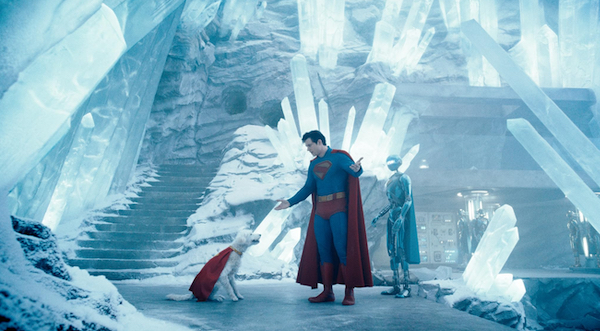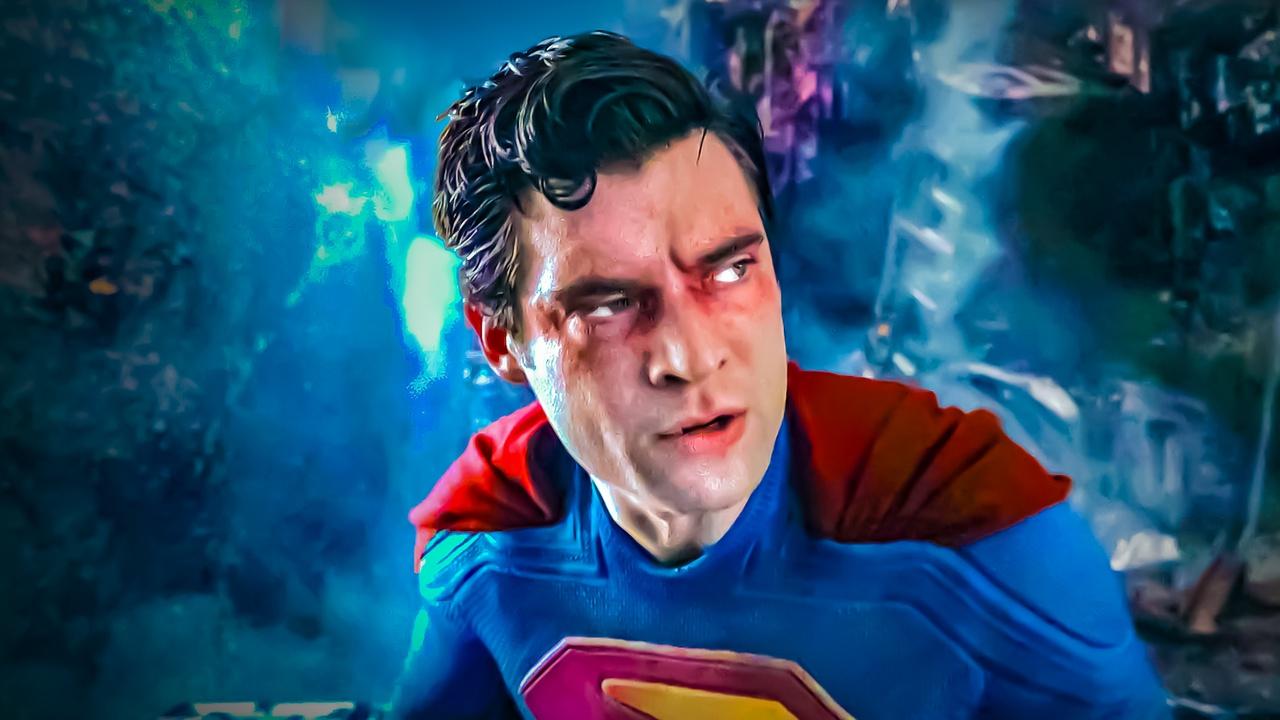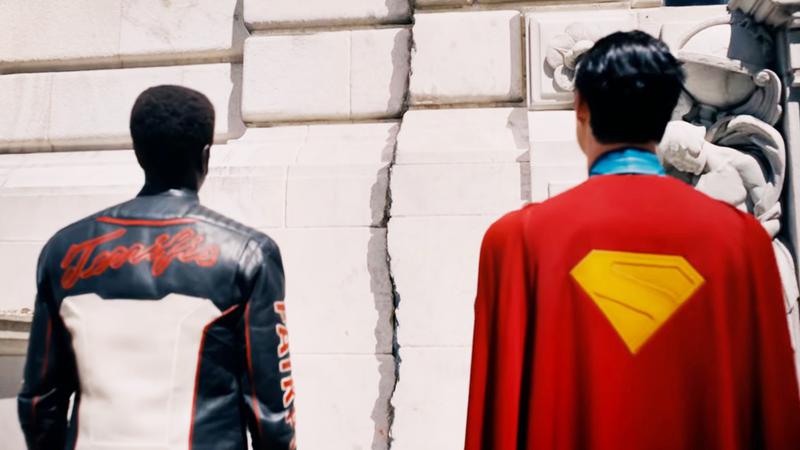Introduction: A New Man of Tomorrow
James Gunn's Superman has launched a bold new era for the DC Universe, and the film is packed with an incredible density of comic book references, hidden details, and tantalizing clues about the future. This isn't just another origin story; it's a deep dive into the heart of a hero who is already established, beloved, and facing his greatest challenges yet. For fans looking to understand every layer of this intricate film, this is the definitive guide. We will break down the movie scene-by-scene, uncovering over 100 Easter eggs, explaining the complex motivations of its characters, and exploring the theories that will shape the DCU for years to come. From the Fortress of Solitude to the final, world-altering confrontation, let's explore the complete story of Superman (2025).
A Hero Falls: The Opening in the Antarctic Wasteland
The film immediately subverts expectations, opening not with a triumphant hero, but with a fallen one. We find Superman in a desolate Antarctic landscape, a location that echoes the post-Crisis comics which established the Fortress of Solitude at the South Pole. He lies broken in a fetal position, a symbolic echo of his arrival on Earth as a helpless infant, bleeding and struggling to breathe after his first-ever defeat at the hands of a mysterious new foe.
This vulnerable image is a powerful and deliberate choice, humbling the god-like figure to show his mortality and humanity from the very first frame. The suit he wears is a beautiful synthesis of classic and modern designs. The vibrant colors and iconic red trunks are a conscious decision to make him appear less intimidating, a friendly, approachable figure for the world to look up to rather than a fearsome alien god. The chest emblem itself is a work of art, combining the thick, powerful "S" from Alex Ross's iconic Kingdom Come with the bright yellow border of the 1940s Max Fleischer cartoons, all topped with the subtly raised collar from the New 52 comics. It’s a design that respects every era of the hero’s history.
With a final, desperate effort, Superman musters a powerful whistle. From the snowy distance, a loyal friend emerges: Krypto the Superdog. A beloved character from the Silver Age, Krypto's inclusion is a clear signal that this new DCU is embracing the wonderful, sometimes silly, heart of the comics. This isn't a dark, gritty take; it's a universe where a dog with a cape and human-level intelligence is a core part of the story. Krypto, whose comic origins often depict him as a test pilot for Kal-El's rocket, drags his master back to the Fortress of Solitude, a breathtaking structure of crystalline ice pillars. Its design is heavily inspired by the classic 1978 Richard Donner film, which cemented this look as the definitive version for generations of fans.
Inside, they are greeted by the Superman Robots, robotic assistants taken directly from the pages of Grant Morrison's seminal All-Star Superman. These loyal machines place the injured hero into a healing chamber, where he is blasted with concentrated yellow solar radiation—a painful, agonizing process that rapidly mends his punctured lungs and damaged organs. As he heals, a holographic message from his Kryptonian parents, Jor-El and Lara Lor-Van, plays. They speak in a newly created, complex Kryptonian language, a brilliant detail that underscores the film's central theme of Superman as an immigrant, forever tied to a heritage and a language he barely knows.
Metropolis Under Siege: The Machinations of Lex Luthor
While Superman recovers, a new threat makes its presence known in Metropolis. An armored figure calling himself the Hammer of Boravia attacks the city, blaming Superman for interfering in an international conflict between the fictional nations of Boravia and Jarhanpur. This figure is, of course, a pawn in a much larger, more sinister game.
In a sleek, sun-drenched command center high above the city, we meet the mastermind: Lex Luthor. Played with a chilling, tech-bro menace, this Lex is a brilliant, egotistical, and deeply insecure billionaire who views Superman not as a savior, but as an existential threat to humanity's potential. His obsession is palpable, and his very first action on screen is to turn away from the blinding light of the sun—the very source of Superman's power and, thematically, the light of truth that Lex cannot stand. His hatred is not just about power; it's about a philosophical opposition to the idea of unearned greatness.
Lex's team is a who's who of obscure DC Comics characters, from his classic henchman Otis to scientists like Sidney Sapperson and Amanda Marie McCoy, rewarding eagle-eyed fans with deep-cut references. He commands the Hammer of Boravia's every move with coded attacks, like a player in a twisted video game. We soon learn the truth: the Hammer is a powerful being known as Ultraman, a clone of Superman created and controlled by Luthor. In the comics, Ultraman is often the evil counterpart to Superman from an alternate Earth and a leader of the villainous Crime Syndicate. The film cleverly adapts this concept, making him a genetically flawed, mentally unstable duplicate. The armored suit, designed to look like a prototype for Lex's own future war suit, conceals a face identical to Superman's, only paler and with a vacant, unsettling gaze.
Lex's plan is twofold: publicly frame Superman as a reckless global menace and secretly locate his hidden base. The initial attack was a ruse, allowing Lex's agent, The Engineer, to track Superman back to the Fortress of Solitude. The Engineer, a being whose body is composed of shape-shifting liquid metal nanites, is a formidable weapon in Lex's arsenal, capable of infiltrating any system and matching nearly any physical threat. Her comic origins lie with the anti-heroic team The Authority, suggesting her inclusion here may be a seed for a future, more complex storyline.
The Man Behind the Cape: A Day at the Daily Planet
The film then transitions to the bustling streets of Metropolis and the iconic offices of the Daily Planet, providing a crucial grounding element. Here, Superman is Clark Kent, a clumsy, mild-mannered reporter who deliberately bumps into people and ducks his head to avoid attention. This classic dual identity, long the subject of fan debate, is given a comic-accurate explanation: Clark wears hypno-glasses. This piece of Kryptonian tech doesn't just hide his eyes; it subtly alters how people perceive his face, posture, and even his voice, making him appear as a completely different, forgettable person. It’s a clever, direct nod to the Silver Age logic that allows the world’s greatest hero to hide in plain sight.
The newsroom is alive with character and detail. We meet a fantastic supporting cast, each bringing a piece of the classic Superman mythos to life:
Perry White: The tough but fair editor-in-chief, whose gruff exterior barely conceals a deep-seated belief in journalistic integrity.
Steve Lombard: The blowhard sports columnist who constantly critiques Clark's "boring" writing, serving as the office's comedic foil.
Jimmy Olsen: The enthusiastic young photographer who, in a hilarious running gag, is an inexplicable ladies' man, a fun twist on his traditionally boyish persona.
Lois Lane: The brilliant, sharp-witted star reporter. She is Clark's girlfriend of three months, and their mature, established relationship is the emotional core of the film. Their chemistry is immediate and palpable, built on mutual respect and intellectual sparring.
Clark's desk is a treasure trove of Easter eggs, from a copy of Lex Luthor's self-aggrandizing book and a poster for the fictional band "The Mighty Crabjoys," to a sticky note referencing the Niagara Falls honeymoon scam from Superman II. Most importantly, we see his deep connection to his adoptive parents, Jonathan and Martha Kent. In a departure from recent adaptations, they are still alive and well in this continuity, providing Clark with the unwavering moral compass that grounds him and serves as his true north.
A Hero Betrayed: The Unraveling Conspiracy
The central conflict ignites when Lex Luthor makes his move. Having accessed the Fortress of Solitude using Ultraman's DNA, The Engineer hacks the Kryptonian archives and downloads the full, unedited message from Jor-El and Lara. Lex then presents a deceptively edited, horrifyingly twisted version to the world.
The doctored message paints Superman's parents as would-be conquerors who sent their son to Earth to rule over its "simple" and "weak" people, take many wives, and establish a new Kryptonian empire. The public turns on Superman in an instant. Hashtags like #SuperSpy and #SuperShit trend online, a clever and pointed commentary on modern social media outrage cycles, which Lex is secretly fueling with an army of "Monkey Bots" programmed to generate rage-bait content. This plot point feels incredibly timely, reflecting a world where misinformation can shape public opinion in a matter of hours.
This twist is a powerful emotional blow for Superman. He has always believed his Kryptonian parents were benevolent figures of science and hope. To learn they may have had imperial ambitions forces him to question his own identity and purpose. Is he the savior he thought he was, or the vanguard of an invasion? It is in this moment of doubt that his relationship with Lois becomes his anchor. Their lengthy, raw, and brilliantly acted interview scene is a masterclass in character development. Lois, embodying the best of her profession, challenges him with the tough questions a real journalist would ask, forcing him to confront the ethical complexities and political ramifications of being Superman, all while navigating their personal relationship.
Enter the Justice Gang: A Kaiju in the City
To keep Superman distracted while The Engineer completes her work, Lex unleashes a "small distraction" in Metropolis: a bio-engineered monster that rapidly grows into a giant, fire-breathing Kaiju. As Superman battles the beast, he is joined by a government-sanctioned team of metahumans known as the Justice Gang.
This is our action-packed introduction to three key DCU players:
Mr. Terrific (Michael Holt): A certified genius and inventor with an army of floating T-Sphere drones that can scan, analyze, and attack with incredible precision. He operates with a calm, intellectual coolness, a stark contrast to his more hot-headed teammates.
Hawkgirl (Kendra Saunders): A reincarnated Thanagarian warrior whose ancient memories make her a fierce and sometimes brutal combatant, wielding a devastating Nth metal mace.
Green Lantern (Guy Gardner): A brash, cocky, and hilariously abrasive member of the Green Lantern Corps who uses his power ring to create comically aggressive constructs, like giant green oven mitts and hands flipping the bird. He embodies the team's chaotic energy.
The team's chaotic and collateral-damage-heavy fighting style stands in stark contrast to Superman's focused effort to protect civilians, culminating in a beautiful, iconic shot where he saves a little girl from an exploding truck. The battle brilliantly highlights a key theme: power without compassion and control is just another form of destruction.
Into the Pocket Universe: A Desperate Rescue
Following the public revelation of the Kryptonian message, Superman, feeling lost and betrayed, turns himself in, hoping to be taken to the same place Lex is holding Krypto. He is transported through a shimmering portal to Lex's Pocket Universe, a private, unstable dimension created using a "mega collider" in direct violation of international accords.
Inside this horrifying prison, Lex holds not only Krypto but also other metahumans and political prisoners in floating, transparent cubes. Here, we meet Rex Mason, a.k.a. Metamorpho, the Element Man, who can transform his body into any substance. In a truly cruel twist, Lex has blackmailed him into compliance by kidnapping his infant son, forcing Rex to turn his hand into Kryptonite to keep Superman perpetually weak and helpless.
Lois and Mr. Terrific stage a daring rescue. Mr. Terrific's infiltration of the facility is a stunning one-shot action sequence, showcasing his incredible efficiency and power as he calmly dismantles Lex's forces with his T-Spheres. Inside the Pocket Universe, Rex has a change of heart and, in a moment of scientific brilliance and sacrifice, forges a miniature yellow sun to restore Superman's strength. The heroes escape just as the unstable portal collapses, but Lex, enraged and having lost all his assets, decides on a final, catastrophic act of revenge.
The Final Confrontation: Humanity's True Strength
Lex reopens the dimensional rift, threatening to tear Metropolis apart. As buildings topple and chaos reigns, Superman returns to save the city. This leads to the final, brutal, and deeply personal confrontation between Superman and his clone, Ultraman. Their fight is a locomotive-force battle through subway tunnels and convention centers, a mirror match of strength where only strategy and heart can win. Seeing his own face contorted with rage and madness is a psychological battle for Superman as much as a physical one.
Meanwhile, the Justice Gang intervenes at the Boravian border, and Lois and Jimmy expose Lex's entire conspiracy by publishing an article built from a series of perfectly timed selfies sent by Lex's disillusioned and mistreated assistant, Eve Teschmacher—a brilliant payoff to an early setup.
The climax of the film is not a punch, but a speech. After defeating Ultraman by cleverly dislocating his own shoulder to flip his clone into the rift, Superman confronts Lex. Bathed in the blinding light of the sun streaming through the command center window, Superman delivers a powerful monologue about what it truly means to be human. He declares that his fears, his mistakes, his capacity to love and be hurt are not weaknesses, but his greatest strength—the very thing that connects him to the people of Earth. It’s a powerful repudiation of Lex's cynical, elitist worldview and a powerful thesis statement for this new Man of Steel.
A New Dawn: Post-Credits and the Future of the DCU
With Lex arrested and his name cleared, the world celebrates Superman once more. In the film's touching final moments, Superman sits in the Fortress of Solitude, watching home movies of his loving adoptive parents, Jonathan and Martha Kent. The yellow sunlight that once caused him pain as it healed his broken body now brings a calm, peaceful smile to his face. He has fully embraced his human upbringing as the true source of his identity, reconciling the two halves of himself.
His quiet moment is interrupted by the drunken, unannounced arrival of his cousin, Kara Zor-El, a.k.a. Supergirl. Her rebellious, punk-rock attitude provides a fantastic and hilarious contrast to her cousin's earnestness and perfectly sets the stage for her own upcoming film, promising a very different kind of Kryptonian hero.
The post-credits scene reveals Mr. Terrific and Superman examining the lingering dimensional crack left by Lex's portal. This ties directly into future storylines, suggesting that the multiverse and its many threats will be a central part of the overarching "Superman Saga." With Man of Tomorrow confirmed as the sequel, alongside projects like Lanterns and Supergirl, the future of the DCU is brighter and more exciting than ever.
Conclusion: More Than Just a Symbol
Superman (2025) succeeds by focusing on the man, not just the superman. It brilliantly explores the idea that our choices, our actions, and our capacity for love are what truly define us, regardless of where we come from. By embracing the rich, colorful, and sometimes weird history of the comics while telling a deeply emotional and profoundly human story, the film has laid a powerful foundation for a new universe of gods and monsters, all anchored by a hero who reminds us of the best in ourselves. The Man of Tomorrow is here, and his journey has only just begun.










No comments:
Post a Comment